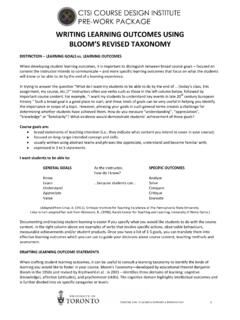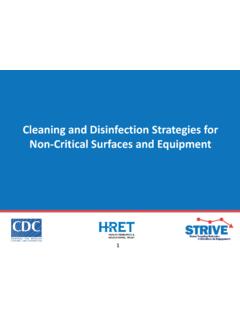Transcription of PEER OBSERVATION OF TEACHING
1 PEER. OBSERVATION . OF TEACHING : EFFECTIVE PRACTICES. THE CENTRE FOR TEACHING . SUPPORT & INNOVATION, UNIVERSITY OF TORONTO, 2017. PUBLISHED BY. The Centre for TEACHING Support & Innovation (CTSI). University of Toronto 130 St. George Street, Robarts Library, 4th Floor Toronto, ON M5S 3H1. Phone: (416) 946-3139. Email: Website: Please cite this publication in the following format: Centre for TEACHING Support & Innovation. (2017). Peer OBSERVATION of TEACHING : Effective practices. Toronto, ON: Centre for TEACHING Support & Innovation, University of Toronto. 2. CONTENTS. Part I: Key Considerations Rationale, Context and Principles Introduction .. 1. The Goals and Benefits of Peer OBSERVATION of 2. Three Models for Peer 2. Setting the Context: Experiences with In-Class OBSERVATION at the University of Toronto .. 3. Online OBSERVATION : An Emerging Context .. 4. Peer OBSERVATION : Recommended Processes.
2 5. Part II: Effective Processes and Practices for Peer OBSERVATION Choosing an 8. The Pre- OBSERVATION Consultation .. 8. Conducting the In-Class 8. Using a Narrative 9. 9. The Post- OBSERVATION Consultation ..10. Providing Meaningful Feedback on TEACHING ..11. Sample Peer OBSERVATION One-to-One classroom TEACHING Squares or Triads ..14. Peer OBSERVATION of Online Courses ..13. The OBSERVATION of TEACHING for Summative Purposes ..14. Part III: Tools and Instruments for OBSERVATION Pre- OBSERVATION Template ..16. OBSERVATION Sample Templates ..18. The Narrative Log ..18. Open-Ended checklist (Criterion-Based) Form .. 20. Online Course Evaluation 23. Post- OBSERVATION Debriefing Appendices APPENDIX A: Additional Resources ..26. APPENDIX B: Best Practices for classroom Visits ..27. APPENDIX C: Types of Questions to Ask/to Avoid ..28. References/Sources 30. PART I: KEY CONSIDERATIONS - RATIONALE, CONTEXT AND PRINCIPLES.
3 Introduction 1. a pre- OBSERVATION conference;. As described by Chism (2007) in Peer 2. an in-person classroom visit (or Review of TEACHING : A Sourcebook, peer online OBSERVATION , in the case of review of TEACHING is informed colleague online courses) during which detailed judgment about faculty TEACHING for observations of the instructor's either fostering improvement or making practice (including classroom personnel decisions (p. 3). Peer review environment and student interactions). of TEACHING is a broad concept that are captured via a template or rubric, includes an array of practices, including and through narrative notes; and, the assessment of TEACHING dossiers, 3. a post- OBSERVATION conference that syllabi, assignments, student and course includes both self-reflection on the evaluations, personal reflections, and peer part of the observee and constructive OBSERVATION .
4 Peer review of TEACHING is feedback from the observer (Wilkerson used for both summative and formative & Lewis, 2002, p. 75). purposes. There are many models of peer Summative peer review of TEACHING is OBSERVATION , and emerging models of geared towards generating information the OBSERVATION of online courses. The needed to evaluate TEACHING for human primary focus of this guide is formative resource-related purposes ( , tenure peer OBSERVATION of TEACHING at the and promotion). As summative reviews University of Toronto, including in are evaluations with a defined purpose in online courses. The guide presents mind, they tend to cover broad categories, different models of peer OBSERVATION . and offer a comparison to peers. Formative and assessment that can be adapted to assessment, in the context of the peer multiple contexts across the institution, review of TEACHING , refers to activities providing tools and instruments for peer and processes that provide instructors OBSERVATION of TEACHING , and offering an overview of how to best use them.
5 [FORMATIVE. with specific feedback that they can use to improve their TEACHING practice. EVALUATION IS]. The feedback generated from formative Although focused on formative THE BASIS FOR THE. practices, the guide outlines how these assessment is intended to provide DEVELOPMENT OF. instructors with robust and detailed processes differ from those used for insights into their TEACHING . As Chism summative purposes, and describes EFFECTIVE TEACHING . states, formative assessment of TEACHING is how these practices might be adapted THROUGHOUT ONE'S. the basis for the development of effective as departments carry out summative CAREER.. TEACHING throughout one's career (p. 5). observations of TEACHING for tenure and promotion purposes, as included (Chism, 2007, p. 5). Peer OBSERVATION , for both summative and outlined in some U of T divisional and formative purposes, is an important guidelines for the assessment of TEACHING component of the peer review of TEACHING .
6 For tenure and promotion. In general, collaborative peer OBSERVATION of TEACHING is comprised of three steps: 1.. A PROCESS WHEREBY A TEACHER PARTICIPATES AS AN OBSERVER IN A LESSON TAUGHT. BY A COLLEAGUE FOR THE PURPOSES OF EXPLORING THE LEARNING AND TEACHING . PROCESS AND ENVIRONMENT AND WHERE THIS OBSERVATION ' LEADS ON TO REFLECTION. AND DISCUSSION, WITH THE UNDERPINNING LONG-TERM AIM OF IMPROVING STUDENTS'. LEARNING.. (Bennett & Barp, 2008, p. 559). The Goals and Benefits of Peer OBSERVATION of Sullivan, Buckle, Nicky, and Atkinson (2012) further TEACHING enumerate the practical benefits of peer OBSERVATION , stating that the process can additionally reaffirm Peer OBSERVATION of TEACHING in higher education has TEACHING skills, provide developmental feedback and been used and evaluated both as a faculty development ultimately maintain high standards in undergraduate technique and a summative evaluation tool for several TEACHING , for example.
7 Peer OBSERVATION in its decades. Studies highlight the value of the practice as a collaborative approach may also play a role in way of foregrounding the TEACHING and learning process, contributing to strong departmental TEACHING climates making TEACHING practice visible, and improving the and cultures (Smith, 2013). quality of TEACHING and student experiences (Fullerton, 1993; Hammersley-Fletcher & Orsmond, 2004; Martin &. Double, 1998; Pressick-Kilborn & te Riele, 2008). Bennett Three Models for Peer OBSERVATION and Barp (2008) summarize the process and outcomes of A review of the literature demonstrates that there are peer OBSERVATION as follows: three basic models of peer OBSERVATION of TEACHING usually conducted within higher education institutions. a process whereby a teacher participates as Gosling (2002) captures these models as follows: 1). an observer in a lesson taught by a colleague an evaluation model, where the primary purpose is for the purposes of exploring the learning and to provide summative feedback for the purposes of TEACHING process and environment and where this appraisal or quality assurance; 2) a developmental OBSERVATION ' leads on to reflection and discussion, model where the overarching goal of OBSERVATION with the underpinning long-term aim of improving is improving TEACHING and learning; and 3) the peer students' learning.
8 (p. 559). review model, where self- and mutual- reflection are emphasized, resulting in formative feedback. As Martin and Double (1998) identify the six main aims of described by Siddiqui et al. (2007), the essence of the peer OBSERVATION as: peer-review model is that teachers observe each other, often in a reciprocal process (p. 297). 1 improving or developing an understanding of personal approaches to curriculum delivery; Several studies demonstrate how the peer review model 2 enhancing and extending TEACHING for the OBSERVATION of TEACHING provides faculty with techniques through collaboration; opportunities for development, and improves TEACHING practice (Bell 2001; Hendry & Oliver, 2012; Sullivan et al., 3 exchanging insights relating to the review of TEACHING performance;. 2012). Hendry and Oliver (2012) write that observing a colleague teach can both show the observing teachers 4 expanding personal skills of self-reflection and evaluation.
9 How new strategies work and enhance their confidence to apply them in their own TEACHING (p. 1), and Sullivan 5 developing curriculum planning skills in et al. (2012) show how the peer OBSERVATION of TEACHING collaboration with peers and colleagues; and, can provide an opportunity to examine both content and delivery of individual course components so that 6 identifying areas in TEACHING practice with particular merit or in need of development. suggestions could be made as to how these might be improved or refined (p. 3). 2. Other benefits include first-hand collegial support and to no preparation for or feedback on in-class TEACHING . the growth of TEACHING -related collaboration (Pressick- Preparation in such cases might include a formative Killborn & te Riele, 2008). Throughout the process, check-in prior to the more formalized OBSERVATION . peer OBSERVATION can act as a valuable opportunity for One interview respondent shared the value in providing reflection, give insight into TEACHING practices, mutual feedback prior to tenure and promotion processes, professional development, and quality improvement in otherwise many new and early career faculty will only TEACHING and learning (Sullivan et al.)
10 , 2012). experience one in-class OBSERVATION as a primarily summative and high stakes activity. Several faculty Setting the Context: Experiences with In-Class members shared positive experiences in engaging in formative in-class OBSERVATION sessions and the post- OBSERVATION at the University of Toronto OBSERVATION debriefing meetings. In addition to their developmental purposes, these experiences can also In a recent report on faculty mentoring for TEACHING serve as important preparation for eventual summative practices at the University of Toronto, the Centre for observations. TEACHING Support & Innovation (CTSI) interviewed a range of faculty members who described peer A group of faculty members who were observed in OBSERVATION of TEACHING experiences. Several faculty weekly in-class observations with a senior faculty members interviewed described occasions in which member felt that such sessions were very helpful and peers from within and outside their department sought formed the basis of a meaningful mentor-mentee feedback on their in-class TEACHING .

